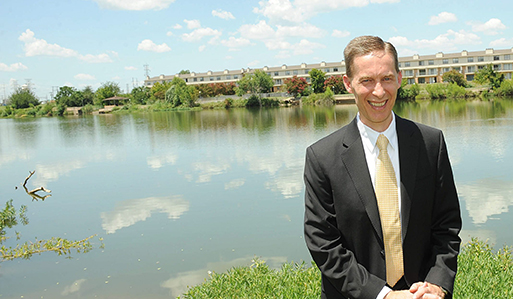
By JOHN WERNER

AP Photo – Rod Aydelotte
jwerner@wacotrib.com
Associated Press
When Ian McCaw took over as Baylor’s athletic director during the tragic summer of 2003, he knew a monumental task stood in front of him.
Baylor’s image had taken a beating when Carlton Dotson was arrested for the murder of former teammate Patrick Dennehy amid a scandal in which the men’s basketball program was banned from postseason competition.
The Baylor football program was at its lowest point in more than three decades after just one Big 12 win in the previous four seasons. Though some sports were thriving, like women’s basketball, tennis and baseball, the failure of high visibility sports like football and men’s basketball tarnished the reputation of Baylor’s athletic program.
Ten years later, a completely different picture has emerged.
Baylor has evolved into an all-around force on the national scene. Art Briles’ football team has reached a school-record three straight bowl games while Scott Drew’s men’s basketball program is experiencing its most productive era in 60 years with Elite Eight appearances in 2010 and 2012 and this year’s NIT championship.
Kim Mulkey’s women’s basketball team bagged national titles in 2005 and 2012 while Matt Knoll’s men’s tennis team nailed down Baylor’s first team national championship in 2004 and continues to soar. Across the board Baylor’s sports are experiencing success, with 10 straight top 50 finishes in the annual Sports Directors’ Cup standings.
“If you look at over the last decade some of the greatest moments in the history of Baylor athletics have taken place,” McCaw said. “Some of the programs that have not historically had success at Baylor have really emerged. I give great credit to our coaches and student athletes. We’re at a point right now looking at the future where every one of our programs are positioned to have success.”
Complementing Baylor’s success on the field has been a building boom along the Brazos River.
Since 2003, Baylor has added major facilities like the Simpson Athletics and Academic Center that houses many of the athletic offices. The Allison Indoor Football Practice Facility, the Hawkins Indoor Tennis Center, the Willis Family Equestrian Center, and basketball and softball practice facilities are among the other buildings that have risen in the last decade.
But the crown jewel will be the $250 million on-campus football stadium that will open in 2014.
“The football stadium is going to change Waco, Texas,” Briles said. “It’s going to do a lot for Baylor and Central Texas. In 10 years, we’re going to look back and ask why we didn’t do that in 1982. Everyone’s going to understand what it will do to increase our visibility and perception, and put us on a level playing field across the nation.”
The mass building projects have been the result of Baylor’s $300 million fundraising efforts that have included the five-year Victory with Integrity campaign that began in 2005 and the recent Baylor Stadium campaign.
“That’s allowed us to have the resources and facilities to compete with the best programs in the country,” McCaw said. “When we finish the football stadium in 2014 and the track to go along with it, I think we’ll have as fine a set of athletic facilities as anybody in the country.”
Revenue gained through Big 12 television contracts has also been vital to the rise of Baylor athletics. Annual television revenue has tripled from $7 million in 2003 to $22 million this year. Likewise, Baylor’s annual athletic budget has nearly tripled from $26 million in 2003 to $73 million this year.
New facilities are essential to competing at the top level of NCAA athletics to attract recruits and stay in the arms race with other schools.
“To perspective student athletes, the quality of the facilities really speak to the quality of the program and the level of commitment,” McCaw said. “Putting together an outstanding coaching staff and first class facilities will give you an opportunity to excel. It gives them the ability to recruit at the highest level.”
Baylor’s athletic success under McCaw’s guidance has raised the profile of the university at many levels and has led to an increase in student applications.
“Ian is an extraordinarily effective leader of Baylor athletics,” Baylor President Ken Starr said. “He knows how to build great programs, captured in the title of the university’s capital projects initiative that has enjoyed such unprecedented success: Victory with Integrity. Baylor Nation is deeply grateful for Ian’s nationally-acclaimed leadership. “
When McCaw arrived from the University of Massachusetts in 2003, he understood that Baylor men’s basketball was in turmoil and the football program was an annual Big 12 cellar dweller that had already gone through three coaches in seven seasons and was starting on a fourth with Guy Morriss in the 2003 season.
But McCaw felt Baylor had the potential to become a strong athletic program in every sport.
“We arrived at a time when there was obviously a tremendous tragedy back in 2003,” McCaw said. “But I’m a very forward-looking person and I think our staff really bought into the vision and the potential, and we had a plan for the future. Being an outstanding academic institution with a Christian mission in the Big 12, I just thought we had the potential to do great things.”
Setting plan in motion
McCaw implemented a five-year strategic plan called Above and Beyond that outlined the athletic program’s goals and objectives which led to the Victory with Integrity developmental campaign that raised $95 million.
The image of the Baylor athletic programs got a big lift when the men’s tennis team won the 2004 national title and the women’s basketball team won the 2005 national title in only Mulkey’s fifth season.
With Steve Smith’s baseball team reaching the 2005 semifinals of the College World Series, Baylor finished a program-best 25th in the Sports Directors’ Cup standings.
“Winning the men’s tennis national championship was a great moment because Baylor had never won a national championship in any sport,” McCaw said. “We hoped we wouldn’t have to wait another 100 years-plus to win the next one. Fortunately, we didn’t because the Lady Bears won the next year. All the success in 2005 created a sense of momentum that Baylor can compete in the Big 12 and compete on a national platform.”
Many of Baylor’s programs continued to rise such as Glenn Moore’s softball program that reached the Women’s College World Series for the first time in 2007 before returning in 2011.
While football made some strides under Morriss, he couldn’t produce a winning season and was dismissed following the 2007 season. McCaw saw how Briles built the University of Houston into a successful program in five years and believed his longtime Texas high school coaching background would be a tremendous asset in recruiting.
McCaw’s hunch paid off as Briles led the Bears to the 2010 Texas Bowl for the school’s first bowl appearance in 16 years. Wins in the Alamo Bowl and the Holiday Bowl followed and Robert Griffin III’s 2011 Heisman Trophy gave Baylor unprecedented national exposure.
“Coach Briles has done a remarkable job, and it has been manifested in several ways,” McCaw said. “We’re on pace to have record season ticket sales in football, and the fundraising success we’ve had with Baylor Stadium has really brought Baylor Nation together. That’s a tribute to the success of the program.”
After taking over a shell of a program in 2003, Drew broke through with the men’s basketball program’s first NCAA tournament appearance in 20 years in 2008. The Bears have sustained their success with the two Elite Eight runs, a 2009 NIT finals appearance and this year’s NIT championship.
‘Loyal, supportive’
“Coach Drew has led one of the greatest turnarounds in college basketball history,” McCaw said. “There’s so much excitement around the Baylor community and it’s great to see people so energized about the program. It’s been a huge part of the overall success of our program.”
Baylor enjoyed its best athletic year ever in 2011-12 as all 19 sports made postseason appearances and set a national record with a combined 129 wins in football, men’s and women’s basketball and baseball. Briles believes McCaw’s leadership and loyalty to his coaches have been vital to Baylor’s all-around success.
“Ian’s the best there is in the business and that’s why he’s recognized nationally,” Briles said. “All you have to do is pull up the facts, and the facts don’t lie. He’s loyal to you and extremely supportive, and those are definite needs for someone in my position.”
A major reason for Baylor’s sustained success is the stability of its coaching staff. While many coaches have had opportunities to move elsewhere, they’ve stayed at Baylor.
Smith has just completed his 19th season as baseball coach while Knoll has headed the men’s tennis program for 17 years. Mulkey, Moore and cross country coach Todd Harbour have headed their programs for 13 years apiece. Additionally, Harbour has been the head track coach for eight years.
Joey Scrivano has coached the women’s tennis team for 11 years while Drew and men’s golf coach Greg Priest have guided their programs for 10 years.
Briles will enter his sixth season this fall, the longest tenure for a Baylor football coach since Grant Teaff coached 21 seasons from 1972-92. Drew believes McCaw has created an atmosphere in the athletic department that has made coaches want to stay.
“With the success people have had, most have chosen to stay and a big reason is they like working with Ian,” Drew said. “Ian is everything you want in a boss. He’s a man of character and very supportive. His suggestions and are usually spot on, and he’s easy to work with. He doesn’t micromanage. He constantly makes sure you have what you need to be successful and gives you the latitude to perform your duties.”
McCaw’s tenure hasn’t been without some difficult times. The Big 12 appeared on the verge of collapse in the summers of 2010 and 2011 and lost Nebraska, Colorado, Texas A&M and Missouri to other leagues. The Big 12 finally found stability last year with the addition of new members TCU and West Virginia.
The NCAA placed Baylor on three years probation in April 2012 following an inquiry that revolved around impermissible phone calls and recruiting violations in the men’s and women’s basketball programs. However, the programs weren’t banned from the postseason and measures were put in place at Baylor to prevent future compliance problems.
With the Big 12 finally stabilized and most of Baylor’s programs performing at a high level, McCaw said he is looking forward to starting his next decade at the helm.
“With our personnel, facilities and resources, we have programs positioned to excel in the Big 12,” McCaw said. “Three national championships, 41 Big 12 titles and back-to-back bowl wins have been huge in building Baylor’s brand. Nationally people are talking about Baylor as a premier athletic program, and that’s a new development.”





